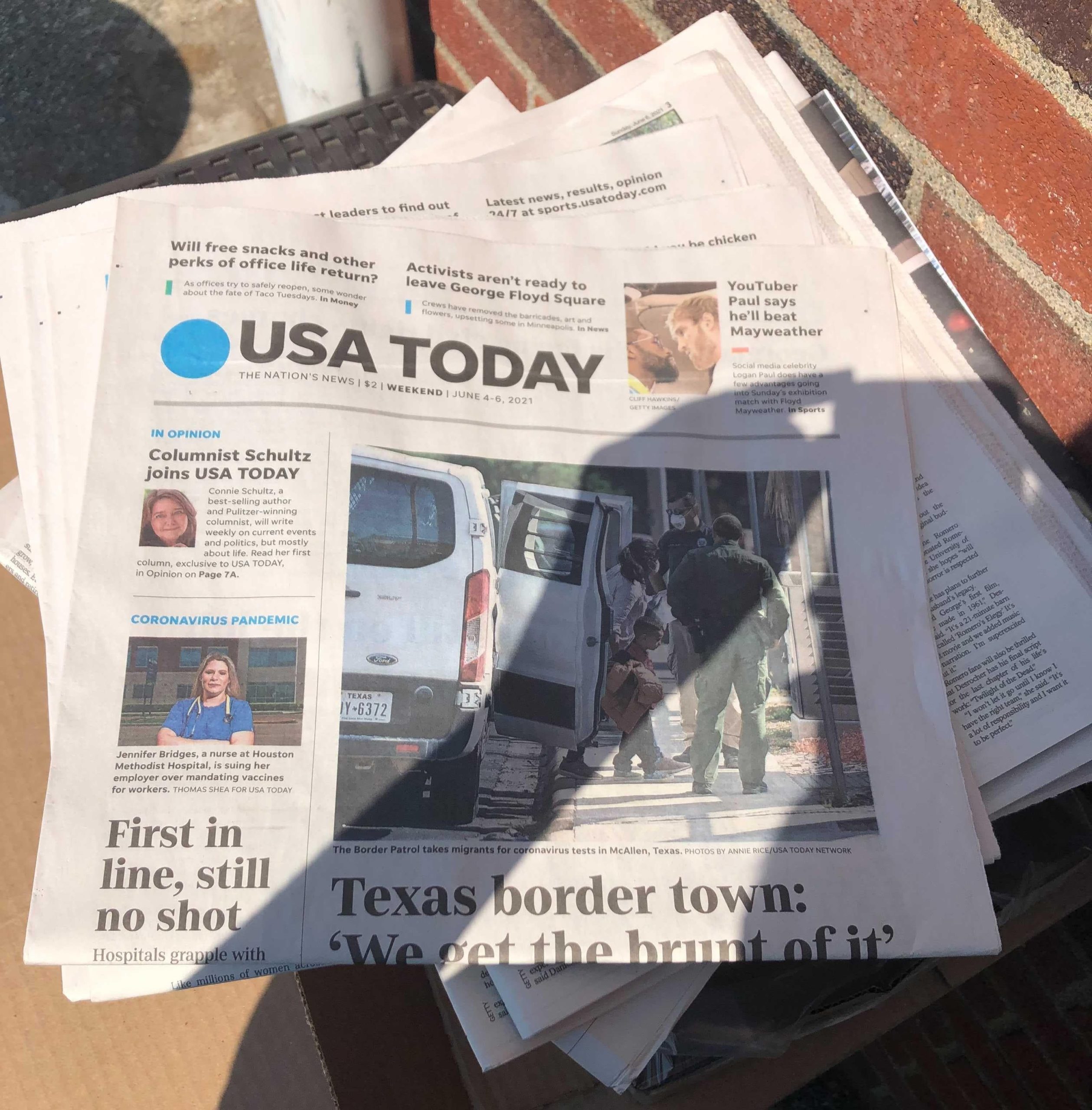In Netflix’s new live-action adaptation of Jeff Lemire’s DC Comics series Sweet Tooth, the sudden appearance of half-human/half-animal hybrids during a pandemic prompts many “regular” humans to begin hunting and murdering the hybrids out of fear and, quite literally, open speciesism. Timed with Sweet Tooth’s premiere, the June 4 weekend edition of USA Today hit newsstands wrapped in a full, front-page advertorial about the show styled as multiple tabloid-like stories about human-animal hybrids, and concerns that they might be a national security risk.
“Hybrid babies born across the US: World reacts to new generation of half-human, half-animal children with both awe and concern,” read one of the ad’s headlines. “General calls hybrids a threat to national security; Activists fight back,” reads another that also included brief “articles.” The page then teased “exclusive photos inside.” Turning to the next page would give you several photos from the first episode of the Netflix series joined by more headlines: “‘Tails’ from a maternity ward in chaos,” and “Silver River Hospital reacts to hybrid pandemonium.”
Is anyone talking about USA Today selling its front page to Netflix for Sweet Tooth? pic.twitter.com/1DGgdO13HT
— Adam Graham (@grahamorama) June 6, 2021
While advertorials have become common in the modern media landscape, what made the Sweet Tooth pieces stand out was how little about them suggested they weren’t actual pieces of news. Regular readers of Gizmodo, perhaps, would have pegged them for what they were, but for everyone else, there was a one-word disclosure in small print above the headline. Everything else about the ads, from the photos (provided by Netflix) to the tone of the writing, to the fact that the ads were acting as the front page of a major newspaper, suggested that they were hard news meant to be taken at face value. It’s not clear how many markets the advertorials were placed in but we could not find them in a cursory search of New York City nor Westchester County, New York.
When Gizmodo reached out to Netflix to ask them about the matter, a representative told us, “We won’t have anyone available to speak to this tactic.” In an e-mailed statement, USA Today’s rep said “the campaign was clearly labelled an advertisement and adhered to our advertising guidelines and protocols.” Those guidelines include “Ads cannot resemble news or front page format of USA Today.” To inquire further about the decision-making process that went into the Sweet Tooth ads, Gizmodo also directly contacted, but did not hear back from, Kevin Gentzel, Gannett/USA Today’s head of marketing. Interestingly, Gentzel spoke out in 2020 when the Tennessean, another paper owned by Gannett, came under fire for running a full-page ad claiming that a nuclear bomb had been placed in Nashville by “Islam.”

Again, to people familiar with the series’ premise, or the reality we live in, this fact might be obvious. But in deciding to use the front page space to promote the comic book show this way, USA Today and its parent company, Gannett, failed to understand the responsibility the press has to guard against misinformation, regardless of whether it’s intentionally malicious or not.
Though the June 4 edition of USA Today also included a real front page just behind the advertorial, everyone understands that newspapers’ front pages are uniquely designed to function as advertisements for the paper as a whole while also informing readers about the contents inside. While a person might not necessarily pick up a newspaper and read it in its entirety, front pages are meant to grab attention with striking photos and gripping headlines that (ideally) tell you the most important thing you need to know about the lead stories. The Sweet Tooth advertorials read a lot like the sort of reporting you often see in tabloids where cryptids and other fictional monsters often make appearances.
But in the same way that people know what newspaper headlines are supposed to do, people also have a general understanding of what sort of journalistic standards differentiate tabloids from national newspapers like USA Today. In certain instances, that same understanding can allow for stunts similar to this, like USA Today’s 2015 Back to the Future Part II commemorative papers, which featured the same front page as the one Marty McFly sees in the Robert Zemeckis film. But unlike the Back to The Future franchise, which was well-established by 2015, Sweet Tooth is a new adaptation of a comics series many people might not be familiar with. Larger than that, though, the series arrives at a time when “fake news” completely dominates and derails news cycles in ways that threaten to undermine journalism as a whole.
When we talk about “fake news,” what we’re actually talking about is misinformation presented as fact. One of the immediate issues posed by misinformation is that consuming it leaves a person misinformed (see how that works?) about things they presumably wanted to know the truth about. In a vacuum, misinformation can harm people individually by making them ill-equipped to engage with facts.
But because it seldom exists in a bubble, misinformation poses a considerably larger and more complicated danger that’s important to understand. As insignificant as individual pieces of “fluff” misinformation like the Sweet Tooth ads are, the proliferation of misinformation in the larger media landscape has resulted in a number of harmful outcomes like the spread of hoaxes and items meant to interfere with elections. In addition to vaccine supply shortages, one of the biggest challenges the world continues to face as the covid-19 epidemic rages on is the disinformation that has been spread about the vaccines that have been developed to halt the virus’ spread.
Unlike tabloids, newspapers become valuable by telling the truth, and they lose that value if people can no longer trust their reputations. Regardless of how one might feel about USA Today, it is the most widely circulated print newspaper in the United States, meaning that people are reading it or, at the very least, seeing what runs on the front page. As lovely as it would be for media literacy to be a fundamental part of our country’s educational system, that is not the case, despite the fact that the media plays a crucial role in shaping our understandings of reality. In the case of covid-19, misinformation is particularly dangerous because of how it encourages people to actively ignore or work against the steps being taken to stop a global pandemic.
Many of the fearmongering stories about the covid-19 vaccines have featured fantastical elements like microchips that turn people into magnetised 5G radio towers — the sorts of things you might expect to see in a comic book and not in the conversations about a real-world, life-saving medicine.
This is part of what made the Sweet Tooth advertorial copy’s actual content something of an issue in its own right, as the fake stories breathlessly described unbelievable human-animal infants being born in maternity wards. Strange as the ads read, the reality is that misinformation often plays into these sorts of conspiracy-tinged stories that stoke people’s fears about society.
The Sweet Tooth ads embodied USA Today’s willingness to let its financial needs butt up against its reputation in a way that can be seen in many modern newsrooms. That was Gannett’s decision to make, but it’s one that also came at the cost of diminishing USA Today’s standing for what ultimately amounted to the physical equivalent of a pop-up ad.
